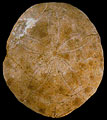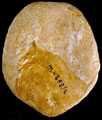Mortensen (1948) points out that Astrolampas seems to be closely related ro Pygurus, to which many of the species were originally referred. Mortensen (1948, p. 135) states that if the apical system of A. productus should be found to be tetrabasal, the genus should be considered a synonym of Pygurus. The apical system of A. productus is distinctly tetrabasal. However, Astrolampas differs from Pygurus by having bourrelets that are not inflated, and narrow phyllodes with two series of pore pairs, the inner series widely separated from the outer. In Pygurus the bourrelets are strongly inflated and the pore series in each half ambulacrum of the phyllodes are always close together (Kier, 1962; p. 52).
Lambert & Thiery (1921, p. 357) refer to seven species in this genus. Kier (1962, p. 52) notes that Lambert\'s A. romani should be referred to as a species of Pygorhynchus, while Cotteau\'s Bothriopygus coquandi does not have an inframarginal periproct and cannot therefore be an Astrolampas, but should be referred to Parapygus.
J. Lambert & P. Thiery. 1909-1925. Essai de nomenclature raisonnee des echinides. Libraire Septime Ferriere, Chaumont, 60
P. M. Kier. 1962. Revision of the cassiduloid echinoids. Smithsonian Miscellaneous Collections, 144 (3) 262 pp.
T. Mortensen. 1948. A monograph of the Echinoidea: 4 (1): Holectypoida, Cassiduloida. Reitzel, Copenhagen, 363 pp., 14 pls.
Pomel, A. 1883. Classification méthodique et genera des Échinides vivante et fossiles. Thèses présentées a la Faculté des Sciences de Paris pour obtenir le Grade de Docteur ès Sciences Naturelles, 503, 131 pp. Aldolphe Jourdan, Alger.




